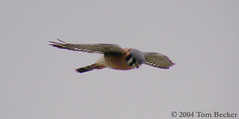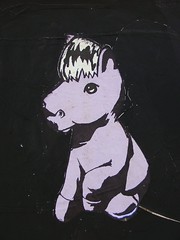The world is a mask that hides the real world.
Thatâs what everybody suspects, though the world we see wonât let us dwell on it long.
The world has ways - more masks - of getting our attention.
The suspicion sneaks in now and again, between the cracks of everyday existenceâ¦the bird song dips, rises, dips, trails off into blue sky silence before the note that would reveal the shape of a melody that, somehow, would tie everything together, on the verge of unmasking the hidden armature that frames this sky, this tree, this bird, this quivering green leaf, jewels in a crown.â¦
As the song dies, the secret withdraws.
The tree is a mask.
The sky is a mask.
The quivering green leaf is a mask.
The song is a mask.
The singing bird is a mask.
Saturday, March 25, 2006
American Kestrel by Tom Becker
Thursday, March 23, 2006
www.chinaview.cn 2006-03-23 21:56:51
HONG KONG, March 23 (Xinhua) -- Tests on a Peregrine falcon found in the New Territories of Hong Kong suggest it may have contracted H5 avian influenza, Hong Kong Agriculture, Fisheries and Conservation Department said Thursday, adding more tests are underway.
The bird, which appeared injured, was collected in Tin Shui Wai of New Territories on March 21. It was sent to the department's Animal Management Center in Sheung Shui of New Territories and died the following day.
More than 6,000 dead birds have been tested for H5N1 avian influenza since late October, with 16 confirmed cases involving two chickens and 14 wild birds.
People are reminded to observe good personal hygiene by the department. They are suggested to avoid personal contact with wild birds as well as live poultry and clean their hands thoroughly after touching them.
Wednesday, March 22, 2006
Coyote Tours NYC: Central Park, then Anesthesia
March 22 (Bloomberg) -- A coyote loose in New York's Central Park was captured by wildlife officials this morning after eluding them for two days.
Officials had corralled the critter several times since it was first spotted March 20, though it managed to escape each time. They finally caught up to the full-grown creature and tranquilized it near the 79th Street transverse, according to Parks & Recreation Department spokeswoman Carli Smith. It will be sent to a wildlife reserve upstate, she said.
Televised video from today showed officials trying to corner the coyote before the animal jumped into a pond and disappeared through a hole in a fence. Officials speculated the coyote entered New York through the Bronx from Westchester County, north of the city.
Coyotes have lived in New York state since the 1920s in all regions except New York City and Long Island, according to the State University of New York College of Environmental Science and Forestry. The so-called Eastern coyote often looks like a German shepherd dog, and large males can weigh as much as 60 pounds (27 kilograms), the college said.
The last time a coyote was captured in the park was in April 1999, Smith said.
Tuesday, March 21, 2006
parlez-vous whalesong?
The songs of the humpback whale are among the most complex in the animal kingdom. Researchers have now mathematically confirmed that whales have their own syntax that uses sound units to build phrases that can be combined to form songs that last for hours.
Until now, only humans have demonstrated the ability to use such a hierarchical structure of communication. The research, published online in the March 2006 issue of the Journal of the Acoustical Society of America, offers a new approach to studying animal communication, although the authors do not claim that humpback whale songs meet the linguistic rigor necessary for a true language.
"Humpback songs are not like human language, but elements of language are seen in their songs," said Ryuji Suzuki, a Howard Hughes Medical Institute (HHMI) predoctoral fellow in neuroscience at Massachusetts Institute of Technology and first author of the paper.
With limited sight and sense of smell in water, marine mammals are more dependent on sound—which travels four times faster in water than air—to communicate. For six months each year, all male humpback whales in a population sing the same song during mating season. Thought to attract females, the song evolves over time.
Suzuki and co-authors John Buck and Peter Tyack applied the tools of information theory—a mathematical study of data encoding and transmission—to analyze the complex patterns of moans, cries, and chirps in the whales' songs for clues to the information being conveyed. Buck is an electrical engineer who specializes in signal processing and underwater acoustics at the University of Massachusetts Dartmouth, and Tyack is a biologist at Woods Hole Oceanographic Institution in Massachusetts.
Suzuki, who began the project as an electrical engineering undergraduate at the University of Massachusetts, Dartmouth, worked with Buck and Tyack to develop a computer program to break down the elements of the whale's song and assign an abstract symbol to each of those elements. Suzuki wanted to see if he could design a computer program that enabled scientists to classify the structure of the whales' songs.
He used the program to analyze structural characteristics of the humpback songs recorded in Hawaii. To measure a song's complexity, Suzuki analyzed the average amount of information conveyed per symbol. He then asked human observers who had no previous knowledge of the structure of the whale songs to classify them in terms of complexity, redundancy, and predictability. The computer-generated model and the human observers agreed that the songs are hierarchical, confirming a theory first proposed by biologists Roger Payne and Scott McVay in 1971.
Suzuki said that information theory also enabled the researchers to determine how much information can be conveyed in a whale song. Despite the "human-like" use of hierarchical syntax to communicate, Suzuki and his colleagues found that whale songs convey less than one bit of information per second. By comparison, humans speaking English generate 10 bits of information for each word spoken. "Although whale song is nothing like human language, I wouldn't be surprised if some marine mammals have the ability to communicate in a complex way," said Suzuki. "Given that the underwater environment is very different from our world, it is not surprising that they would communicate in rather a different way from land mammals."
The structure of the humpback whale song is repetitive and rigid. The whales repeat unique phrases made up of short and long segments to craft a song. There are multiple layers, or scales, of repetition, denoted as periodicities. One scale is made up of six units, while a longer one consists of 180-400 units. The combined periodicities give the song its hierarchical structure.
Suzuki compared his new technique for animal communication research with more traditional models, such as the first order Markov model that is used to analyze bird songs, which are often shorter and simpler in structure than humpback whale songs. The Markov model proved inadequate for the whale song's complex structure.
Information theory, in contrast, proved perfect for analyzing humpback whale songs because it provided a quantitative analysis of the complexity and structure of the songs. "Information theory was the right choice because it allows one to study the structure of humpback songs without knowing what they mean," said Suzuki.
"I hope that knowing the hierarchical structure in humpback songs will inform research in other fields, such as evolutionary biology," said Suzuki. The technique he developed is already being used by a postdoctoral fellow in Buck's laboratory to analyze recently recorded songs of humpback whales from Australia.







